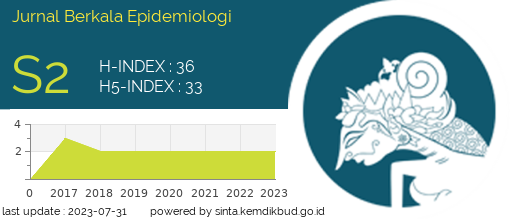STRESS AND INADEQUATE FRUIT-VEGETABLE INTAKE AS MODIFIABLE RISK FACTORS FOR TYPE 2 DIABETES IN YOGYAKARTA
Stres dan Konsumsi Buah-Sayur Kurang sebagai Faktor Risiko Modifiable Diabetes Tipe 2 di Yogyakarta

Downloads
Background: Type 2 diabetes mellitus (T2DM) remains a significant global public health issue, with rising prevalence, including in Indonesia. At the same time, numerous studies have investigated modifiable risk factors of T2DM. To date, stress, fruit, and green-leafy vegetable consumption as risk factors of T2DM remain limited. Purpose: This study investigated the association between stress, fruit, and green-leafy vegetable consumption with T2DM occurrence among individuals under the supervision of Kalasan Public Health Center, Sleman, Yogyakarta. Methods: A cross-sectional study was conducted among 356 registered outpatients selected through purposive sampling. Stress levels were measured using the WHO Self-Reporting Questionnaire, while fruit and vegetable consumption was assessed using the Indonesia Basic Health Research 2018 questionnaire. T2DM status was determined based on fasting blood sugar levels recorded in medical records and confirmed by a physician's diagnosis. Results: Stress was linked to a higher probability of T2DM (Adjusted Odds Ratio (AOR)=2.61; 95% CI=1.25–5.44). Consuming fruit and green-leafy vegetables 2–3 times per week was associated with a lower likelihood of having T2DM (AOR=0.27; 95% CI=0.13–0.56 and AOR=0.07; 95%CI=0.03–0.20, respectively). Conclusion: Stress increases the probability of T2DM. Fruit and green-leafy vegetable consumption 2-3 times per week was associated with a reduced likelihood of T2DM. These findings emphasize the need for targeted public health interventions promoting stress management and healthy dietary patterns strategies to mitigate T2DM risk in primary healthcare settings.
Antar SA, Ashour NA, Sharaky M, Khattab M, Ashour NA, Zaid RT, et al. Diabetes mellitus: Classification, mediators, and complications; A gate to identify potential targets for the development of new effective treatments. Biomed Pharmacother. 2023;168:115734.
ElSayed NA, Aleppo G, Aroda VR, Bannuru RR, Brown FM, Bruemmer D, et al. Classification and diagnosis of diabetes: standards of care in diabetes—2023. Diabetes Care. 2023;46(Supplement_1):S19–40.
Ong KL, Stafford LK, McLaughlin SA, Boyko EJ, Vollset SE, Smith AE, et al. Global, regional, and national burden of diabetes from 1990 to 2021, with projections of prevalence to 2050: a systematic analysis for the Global Burden of Disease Study 2021. Lancet. 2023;402(10397):203–34.
Luk AOY. Changing landscape of diabetes in Asia–What are the unmet needs? J Diabetes Investig. 2024;15(4):402–9.
Wahidin M, Achadi A, Besral B, Kosen S, Nadjib M, Nurwahyuni A, et al. Projection of diabetes morbidity and mortality till 2045 in Indonesia based on risk factors and NCD prevention and control programs. Sci Rep. 2024;14(1):5424.
Health Research and Development Agency. Riskesdas National Report 2018. Jakarta; 2019.
Lee SH. The growing challenge of diabetes management in an aging society. Diabetes Metab J. 2023;47(5):630–1.
Yan Z, Cai M, Han X, Chen Q, Lu H. The interaction between age and risk factors for diabetes and prediabetes: a community-based cross-sectional study. Diabetes, Metab Syndr Obes. 2023;85–93.
Bellary S, Kyrou I, Brown JE, Bailey CJ. Type 2 diabetes mellitus in older adults: clinical considerations and management. Nat Rev Endocrinol. 2021;17(9):534–48.
Dhankhar S, Chauhan S, Mehta DK, Nitika, Saini K, Saini M, et al. Novel targets for potential therapeutic use in Diabetes mellitus. Diabetol Metab Syndr. 2023;15(1):17.
Andersson DP, Kerr AG, Dahlman I, Rydén M, Arner P. Relationship between a sedentary lifestyle and adipose insulin resistance. Diabetes. 2023;72(3):316–25.
Safitri AZ, Fajariyah RN, Astutik E. Risk factors of diabetes mellitus in urban communities in Indonesia (IFLS 5). J Berk Epidemiol. 2021;9(184):10–20473.
Zheng JS, Sharp SJ, Imamura F, Chowdhury R, Gundersen TE, Steur M, et al. Association of plasma biomarkers of fruit and vegetable intake with incident type 2 diabetes: EPIC-InterAct case-cohort study in eight European countries. bmj. 2020;370.
Yen TS, Htet MK, Lukito W, Bardosono S, Setiabudy R, Basuki ES, et al. Increased vegetable intake improves glycaemic control in adults with type 2 diabetes mellitus: a clustered randomised clinical trial among Indonesian white-collar workers. J Nutr Sci. 2022;11:e49.
Barouti AA, Tynelius P, Lager A, Björklund A. Fruit and vegetable intake and risk of prediabetes and type 2 diabetes: results from a 20-year long prospective cohort study in Swedish men and women. Eur J Nutr. 2022;61(6):3175–87.
Halvorsen RE, Elvestad M, Molin M, Aune D. Fruit and vegetable consumption and the risk of type 2 diabetes: a systematic review and dose–response meta-analysis of prospective studies. BMJ Nutr Prev Heal. 2021;4(2):519.
Gorini F, Sabatino L, Gaggini M, Chatzianagnostou K, Vassalle C. Oxidative stress biomarkers in the relationship between type 2 diabetes and air pollution. Antioxidants. 2021;10(8):1234.
Roy K, Iqbal S, Gadag V, Bavington B. Relationship between psychosocial factors and glucose control in adults with type 2 diabetes. Can J Diabetes. 2020;44(7):636–42.
Shen J, Greenberg BH. Diabetes management in patients with heart failure. Diabetes Metab J. 2021;45(2):158–72.
Ingrosso DMF, Primavera M, Samvelyan S, Tagi VM, Chiarelli F. Stress and diabetes mellitus: pathogenetic mechanisms and clinical outcome. Horm Res Paediatr. 2023;96(1):34–43.
Sadiq IZ, Usman A, Muhammad A, Ahmad KH. Sample size calculation in biomedical, clinical and biological sciences research. J Umm Al-Qura Univ Appl Sci. 2024;1–9.
Alessi J, Becker AS, Amaral B, de Oliveira GB, Franco DW, Knijnik CP, et al. Type 1 diabetes and the challenges of emotional support in crisis situations: results from a feasibility study of a multidisciplinary teleintervention. Sci Rep. 2022;12(1):8526.
Kivimäki M, Bartolomucci A, Kawachi I. The multiple roles of life stress in metabolic disorders. Nat Rev Endocrinol. 2023;19(1):10–27.
Chilunga FP, Schwerzel PS, Meeks KAC, Beune E, Bahendeka S, Mockenhaupt F, et al. Associations of psychosocial stress with type 2 diabetes and glycaemic control among Ghanaians: The RODAM study. Diabet Med. 2023;40(1):e15006.
Olofsson C, Discacciati A, Åkesson A, Orsini N, Brismar K, Wolk A. Changes in fruit, vegetable and juice consumption after the diagnosis of type 2 diabetes: a prospective study in men. Br J Nutr. 2017;117(5):712–9.
Adokwe JB, Waeyeng D, Suwan K, Camsanit K, Kaiduong C, Nuanrat P, et al. Plant-based Diet and Glycemic Control in Type 2 diabetes: evidence from a Thai health-promoting hospital. Nutrients. 2024;16(5):619.
Szabo Z, Koczka V, Marosvolgyi T, Szabo E, Frank E, Polyak E, et al. Possible biochemical processes underlying the positive health effects of plant-based diets—A narrative review. Nutrients. 2021;13(8):2593.
Hay SI, Abajobir AA, Abate KH, Abbafati C, Abbas KM, Abd-Allah F, et al. Global, regional, and national disability-adjusted life-years (DALYs) for 333 diseases and injuries and healthy life expectancy (HALE) for 195 countries and territories, 1990-2016: A systematic analysis for the Global Burden of Disease Study 2016. Lancet. 2017;390:1260–344.
Gelaye Y. Quality and nutrient loss in the cooking vegetable and its implications for food and nutrition security in Ethiopia: a review. Nutr Diet Suppl. 2023;47–61.
Kanaley JA, Colberg SR, Corcoran MH, Malin SK, Rodriguez NR, Crespo CJ, et al. Exercise/physical activity in individuals with type 2 diabetes: a consensus statement from the American College of Sports Medicine. Med Sci Sports Exerc. 2022;54(2):353.
- Every manuscript submitted to must observe the policy and terms set by the Jurnal Berkala Epidemiologi
- Publication rights to manuscript content published by the Jurnal Berkala Epidemiologi is owned by the journal with the consent and approval of the author(s) concerned. (download copyright agreement)
- Complete texts of electronically published manuscripts can be accessed free of charge if used for educational and research purposes according to copyright regulations.

JBE by Universitas Airlangga is licensed under a Creative Commons Attribution-ShareAlike 4.0 International License.























